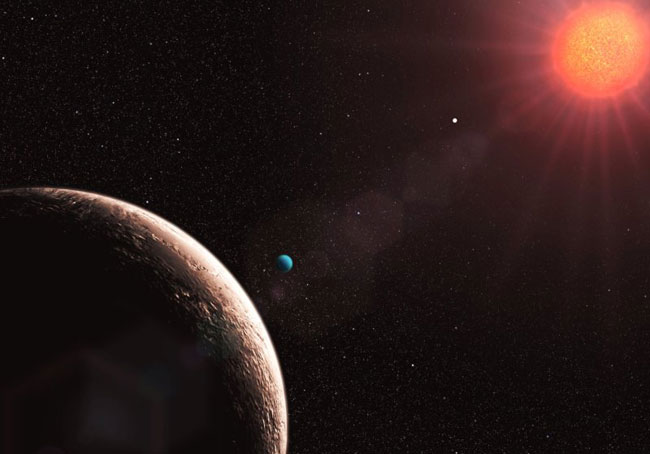Discovery of Earth-mass Planet Looms

Thediscovery of the lightest exoplanet ever found, less than twice the mass of theEarth, has electrified a week-long meeting on astronomy and space science inEurope.
Thestunning finding was made by a team headed by Michel Mayor of the GenevaObservatory. The icing on the cake is a related discovery that a previouslydiscovered ?super-Earth? orbiting the same star appears to reside in thehabitable zone.
The findingportends the discovery of a true Earth-mass planet, which could come in abouttwo years, Mayor said.
Mayor madethe very first discovery of an exoplanet, a Jupiter-sized world that orbits thestar 51 Pegasi, in 1994. Among his many planet discoveries since then atESO?s La Silla Observatory in Chile, Mayor has made a specialty of observingthe star Gliese 581. Located 20.5 light-years away in theconstellation Libra (?the Scales?), Gliese 581 is a red dwarf star with onlyone-third of the mass of our sun.
Two yearsago, Mayor discovered a planet the size of Neptune and two super-Earthsorbiting this star. The newly discovered planet, named Gliese 581 e, isnow the fourth known planet in this solar system and the lightest, weighing inat only 1.94 Earth masses. It fliesround the star at dizzying speed, taking just 3.15 days to complete anorbit. ?The surprise for me was to discover a planet with by far the lowestmass seen to date,? says Mayor.
This newplanet orbits so close to the star that its water would have boiled away longago. It is therefore not inthe habitable zone ? the region of a solar system where water can stayliquid on the surface of a rocky planet, and, consequently, where scientistsexpect life can occur. In our solar system, the habitable zone is roughlybetween the orbits of Venus and Mars (with Earth sitting not quite in themiddle).
In finding thenew planet, Mayor has been able to more accurately determine the orbit for theoutermost planet, Gliese 581 d. One of the super-Earths in the solarsystem, this planet is closer to the host star than was thought when it wasdiscovered in 2007. And that provided the second great surprise. ?It isthe only (Earth-like) exoplanet found inside the habitable water zone of theparent star,? says Mayor.
Breaking space news, the latest updates on rocket launches, skywatching events and more!
Gliese 581d is 7 Earth-masses, and team member Stephane Udry says the planet is probably toomassive to be made only of rocky material. ?We can speculate that it isan icy planet that has migrated closer to the star,? he says. At the Europeanmeeting, Mayor added the latest news indicated, ?No icebergs, but there may bean ocean at the surface, meaning this is a new class of ocean planet.?
To detectexoplanets, Mayor?s team studies a star?s radial velocity, in which the tinytugs exerted by orbiting exoplanets produce a complex wobble in the star. Thiswobble can be analyzed to learn about properties of the planets in the solarsystem. The velocity of a star with multiple planets has to be followedfor several years to discover the different properties of its orbiting planets,and this requires instrumentation that is extremely stable from year to year --one of the big challenges in detecting exoplanets through the radial velocitytechnique.
The team?sobserving program began back in 2004 with a sample of 400 sun-like stars.
Mayor isnow scooping up small exoplanets that have been missed by a rival searchtechnique (called transit photometry) which involves measuring the tiny fall ina star?s magnitude when an exoplanet passes between the star and the Earth.Both techniques, transit photometry and radial velocity, are strongly biased tocatch giant planets with the mass of Jupiter or more, as well as smallerplanets that orbit very close to their star. But to find small planets orbitingwithin a star?s habitable zone, Mayor?s approach now seems to have the edge.
The teamhas found that one-third (30%) of exoplanet systems discovered to date includesmall bodies. ?We have discovered a new category of small exoplanets,? saysMayor. ?Within a couple of years we will drive down our lower limit ofdetection to the mass of the Earth. The next challenge after that is to detect a twin of theEarth in the habitable zone of a solar-type star.?
The nextstage for Mayor?s team is to migrate the detection technology from the current3.6-meter telescope to ESO?s 8-meter Very Large Telescope in order to improvethe precision of observations. After that, Mayor looks forward to using theEuropean Extremely Large Telescope (E-ELT), a 42-meter eye-on-the-sky that isplanned to be operating by 2018.
Currentlyin the later stages of design, this facility will be capable of directlyimaging larger exoplanets, and possibly will be able to search theiratmospheres for biosignatures. E-ELT will answer fundamental questions on theformation and evolution of exoplanets, bringing us one step closer to answeringthe question: are we alone?
- Astrobiology Roadmap Goal 1: Habitable Planets
- Living with a Red Dwarf
- Top 10 Most Intriguing Extrasolar Planets
